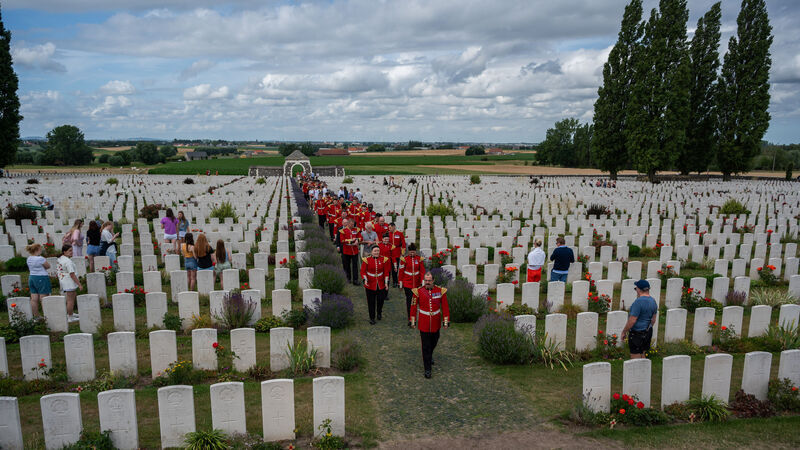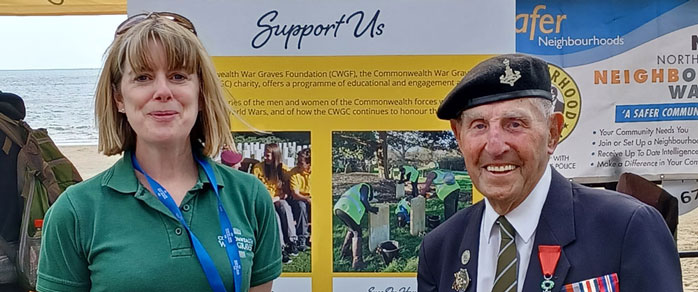24 February 2025
Young Soldiers: The Tragic Stories of CWGC's youngest World War casualties
Did you know that hundreds of thousands of teenagers served in the Armed Forces in the World Wars? Join us as we share the stories of some of the youngest casualties commemorated by CWGC.
Youngest casualties of the World Wars
How many teenagers enlisted in World War One?

Image: Men of the 6th Battalion, Black Watch (51st Division) about to encamp in woods near St. Imoges after the capture of the Bois de l'Aulnay, 25 July 1918. Note the young age of the soldier in the left middle foreground, almost certainly underaged (© IWM (Q 11093))
While the average age of a British Tommy in the First World War was 26, it is estimated some 250,000 boys aged 19 or under enlisted in the armed forces of the British Empire in the First World War.
Britain could call on 700,000 men ready to fight at the outbreak of the war. This was dwarfed by continental armies. The Imperial German Army, for example, could muster 3.7 million men in uniform.
Minister of War Lord Kitchener believed a further 500,000 men could be raised to give Britain a fighting chance, but the fact is Britain was greatly outnumbered in 1914.
The age of enlistment between 1914-1916 was 19. With manpower requirements building as the casualties mounted on the Western Front and theatres around the world, this was lowered to 18 in 1916, which remained the minimum age of enlistment/conscription for the rest of the war.
The demand for able-bodied men was such that recruiters sometimes ignored age limits and basic height requirements.
There are probably apocryphal stories of recruiters initially rejecting teenage recruits for being too young but asking them to take a walk around the block and “come back when they’re older” before accepting their application.
While they may not be strictly true, such tales illustrate how recruiters could, and often did, turn a blind eye to young enthusiastic recruits. Those early developers could rely on their older appearance to hoodwink recruiters too.
However, when it became obvious that such soldiers were way below the age limit and fitness standards, they would be sent home. Those with birth certificates could be traced by anxious and concerned parents and pulled away from their units, for instance.
1 in 5 boy soldiers were sent home when their true age was revealed.
But with many not being able to afford birth certificates at the time, and lacking passports, it was easy to lie about their age and even their identity. Many boy soldiers signed up using assumed names.
Boy soldiers gradually faded out after 1916 with the introduction of conscription.
This was not necessarily the case in the Royal Navy.
The Senior Service has had a long tradition of boys serving at sea. It was not uncommon to find boys as young as 14 serving aboard naval ships and merchant vessels, usually in very menial, low-ranking positions.
Why did teenage soldiers enlist in the armed forces in the First World War?

Image: First World War recruitment poster encouraging enlistment (© IWM (Art.IWM PST 11874))
“News placards screamed out at every street corner, and military bands blared their martial music in the main streets of Croydon. This was far too much for me to resist and, as if drawn by a magnet, I knew I had to enlist straight away.” – George Coppard MM.
The above quote from George Coppard shows the pressures young people were under at the start of the First World War. Young men of all ages were caught up in patriotic fever, swept up by patriotic propaganda playing on a sense of national duty and service, driving them into the armed forces.
George was 16 years old when he signed up. He would earn the Military Medal for his conduct on the Western Front and, luckily, survived the war.
Public pressure on young men to enlist was huge. James Lovegrove had first tried to enlist in 1914 aged 16 after attending a concert where patriotic songs were played all night. Initially turned away for being too young, James was left heartbroken and humiliated. If others were doing their bit, why couldn’t he?
One year later, James was cornered in the street by women brandishing the dreaded white feathers. Those “gifted” white feathers were considered cowards, putting further pressure on the teenage James to sign up.
James went on to serve on the Western Front, participating in the Battle of Arras in 1917.
This patriotic fervour wasn’t restricted the UK. In the Dominions, particularly Canada, New Zealand, and Australia, young men were encouraged to do their bit for the war effort. Boy soldiers signed up in these nations too.
In the early 20th century, young people didn’t enjoy the opportunities for travel and adventure they do today. The school leaving age was 14 and opportunities for higher education, particularly among the working class, were extremely limited. For some, life in the military would be their only chance to travel overseas or do exciting work.
The youngest recorded British soldier to enlist was Sidney George Lewis. Sidney signed up with the East Surrey Regiment at the tender age of 12! Sidney fought at the Battle of the Somme, aged 13, serving with the Machine Gun Corps.
His parents had no idea where he was. Sydney’s whereabouts were revealed by a comrade on leave telling his mother Sydney was in France. His mother went to the war office and demanded Sydney’s release and so Sydney returned to England.
Youngest casualties of the First World War
Commonwealth War Graves commemorates 46 casualties of the First World War aged 14. The great majority of them were naval personnel, lost at sea when their vessels were sunk.
According to our records, over 74,000 servicemen and women aged between 14 and 19 died in military service during the First World War. This number includes all members of the armed forces in all nations whose war dead we commemorate.
Private 2nd Class Thomas Joseph Woodgate
 Image: A painting of Private 2nd Class Thomas Joseph Woodgate (Copyright unknown)
Image: A painting of Private 2nd Class Thomas Joseph Woodgate (Copyright unknown)
Irish combatant Private 2nd Class Thomas Joseph Woodgate had lied about his age when he enlisted in the Royal Air Force in September 1918.
His attestation papers show Thomas’ birth date of September 3rd, 1918, conventionally making him exactly 18 years old. The truth is Thomas was just a boy of 14 years old.
Towards the end of the Great War, the nascent RAF enjoyed a surge of recruits with young people looking to learn a trade. Thomas was one such person, joining the RAF 23rd Training Squadron as an apprentice mechanic.
Thomas died alongside 500 other servicemen and women, passengers, and crew when RMS Leinster was sunk by a German U-boat in the Irish Sea on 10 October 1918, making him one of the youngest casualties of the Great War.
Apart from his age, the other great tragedy of Thomas’ death is the war in Europe would end just a month later. Not only was he one of the youngest casualties, but he was among the last to die too.
Private Jim Martin
 Image: Private Jim Martin (Australian War Memorial)
Image: Private Jim Martin (Australian War Memorial)
Jim Martin was the only son and third child of parents Charles and Amelia Martin of Tocumwal, New South Wales, Australia.
Schooled at Manningtree Road State School, Jim had received basic military training as a junior cadet under the compulsory training scheme.
Come the First World War, Jim enlisted in the Australian Imperial Force on 12 April 1915, claiming to be 18 years old. He joined up against his parent’s wishes but threatened to enlist under a pseudonym and never write to them unless they relented.
James was assigned to the 21st Battalion, and set sail for Egypt, arriving in July 1915. He and his unit were destined for the ill-fated Gallipoli Campaign.
In late August, James was sent to Gallipoli following the failed August Offensive. On the way, their transport ship, HMT Southland, was torpedoed by a German submarine off the coast of Lemnos, Greece. The crew and passengers spent four hours in the water before they were rescued.
James finally arrived in the Dardanelles in September 1915. He wrote to his parents saying, “I am doing splendid over here”, and telling them not to worry. The mail system had broken down, so any replies sent by his family in Australia failed to reach James.
As the campaign dragged on and winter sent in, soldiers began to fall ill in the cold weather and poor conditions. Temperatures plunged and heavy rains began.
James contracted enteric fever in the trenches but refused treatment for over a fortnight. He was evacuated to the hospital ship Glenart Castle on 25 October 1915 but died of heart failure that night.
James was buried at sea and is subsequently commemorated on the Lone Pine Memorial.
Private Clifford Robinson Oulton
 Image: Private Clifford Robinson Oulton (Canadian Virtual War Memorial)
Image: Private Clifford Robinson Oulton (Canadian Virtual War Memorial)
Clifford Oulton is the youngest Canadian serviceman to fight and fall in the First World War.
Born on 2 December 1901, Clifford was one of six children born to George and Albert Oulton. The family lived in Bridgedale, Albert Country, New Brunswick.
There is no record of Clifford’s motivation to sign up, but like young men across the British Empire, he may have craved excitement and adventure overseas.
His father had died at some point between 1911 and 1916, so this may have had a motivating effect on the young Clifford, his soldiers’ pay going to help support the family.
What we do know is that Clifford lied about his age on his attestation papers, giving his birth date as December 2, 1899. Like Jim Martin and Thomas Woodgate, Clifford claimed he was 18.
With his enlistment, Clifford joined the estimated 20,000 underage Canadian soldiers. He did, however, meet the minimum height and weight requirements, standing at 5’ 4” and weighing 120 lbs.
Clifford trained with the 145th Battalion and sailed for England in October 1916. He was then transferred to the 9th Reserve Battalion and arrived in France on October 27. Clifford was then taken on strength to the 5th Canadian Mounted Regiment and headed for the front.
The Canadian boy soldier saw plenty of action. He arrived on the Somme just in time for the final Canadian offensive in November 1916.
Clifford then took part in the nation-shaping victory at Vimy Ridge when the Canadian Corps fought as one unit for the first time, storming German-held high ground. He then fought at Hill 70.
Sadly, Clifford was killed in action at the brutal battle of Passchendaele. On the morning of October 31, Clifford was shot multiple times, possibly by machine-gun fire. He was sent to Clearing Station 44 where he died of his wounds on November 1, 1917, aged 15 years and 334 days old.

Want more stories like this delivered directly to your inbox? Sign up for our newsletter for regular updates on the work of Commonwealth War Graves, blogs, event news, and more.
Sign UpYoung soldiers of World War Two
New war, new young recruits

Image: A group of young British soldiers (Image: © IWM (H 5911))
“It’s surprising how quickly a 17-year-old gets hardened – not indifferent but detached. You get accustomed to wounds and death…” – Bill Edwardes
As their fathers had done, the youth of the UK and British Empire were called on the serve when war broke out in Europe in September 1939.
Conscription, introduced in Britain at the very start of the Second World War, began at 18 years old, but again underage soldiers slipped through.
Youths as young as 16 could serve in the Home Guard, often alongside older veterans of the First World War, but still thousands of boys aged between 14-16 found themselves in the armed forces.
The same pressures and motivations that drove teenagers to enlist in the Great War remained: patriotism; doing your bit; adventure and excitement.
Take Bill Edwardes of 1st Battalion, Worcestershire Regiment. Bill had been evacuated to the countryside at the start of the war but returned to London to work in a factory aged 16. Craving more, he enlisted in 1943.
“I’m 17-and-a-half sergeant”, he told his recruitment officer, as reported by History Extra. The recruiter took him at his word, and, despite his mother’s protests, Bill was soon in Maidstone for training.
“Was I daft? Yes and no,” Bill said. “Consider this, I was something of an urchin. I wasn’t very well educated. I joined the army. I did my primary training and within three months I’d learned to ride a motorbike, drive a Bren carrier, to fire all sorts of weapons – I was happy as Larry. It did me good. It was just the fighting bit that came later that didn’t do me good.”
Bill was trained as a stretcher bearer. At 17, he was too young to go overseas, but by the time D-Day came around, authorities turned a blind eye. He was present at some of the most vicious battles of the Normandy Campaign, such as the fights for Hill 112 and Mount Pincon.
Bill survived the war, but many of his young comrades did not.
At the Commonwealth War Graves Commission, we commemorate 38,017 servicemen of the Second World War aged between 14-19 across all branches of the armed forces and merchant fleet.
Private Robert E Johns
 Image: Private Bobby Johns
Image: Private Bobby Johns
Private Robert Edward Johns was the youngest British paratrooper to drop into Normandy on the night of 5/6 D-Day ahead of the main invasion force. He was also the youngest to die.
A tall and well-built teenager, Robert, known as “Bobby” to his comrades, enlisted at just 14, lying about his true age, running away from his Portsmouth home.
Bobby’s actions terrified his parents Henry and Daisy. They were still mourning the death of his older brother, William, a submariner killed when his boat, HMS Narwhal was bombed in the North Sea in July 1940.
Distraught at the disappearance of their son, the Johns contacted his friends, police, and local authorities to no avail. They finally filed an “underage enlistment” report and The War Office began its investigation. However, the rapid planning and preparation for D-Day was the priority, meaning locating the young Bobby Johns wasn’t top of the military authorities’ agenda.
Meanwhile, Bobby had volunteered for the Parachute Regiment, passed his jump course in January 1944, and was posted to ‘A’ Company, 13th (2/4th South Lancashire) Battalion. His instructors reported that Bobby was “the youngest pupil on the course, but best performer”.
Bobby was just 15 when he earned his paratroopers’ wings. It wouldn’t be long until he saw action.
On the night of D-Day, Bobby and his battalion, as part of the 6th Airborne Division, were dropped into action near Ranville on the Normandy coast. The town was captured in the early hours, but the paras spent the next few days withstanding Wehrmacht counterattacks.
After Ranville, the 13th Battalion moved on to Caen. The city was subject to heavy fighting during the Normandy campaign and proved a tough nut to crack with fighting raging into July.
As the paras were heading into action, the War Office sent Henry and Daisy a letter. Bobby had been found! Sadly, there would be no happy ending.
Military police had reached Bobby’s unit but found he had been killed in action, struck dead by a sniper’s bullet on July 23, 1944. He is buried in Ranville Cemetery in the town he helped liberate on D-Day.
Boy Reginald Earnshaw
 Image: Boy Reggie Earnshaw
Image: Boy Reggie Earnshaw
Reginald Earnshaw was officially declared the youngest known British service casualty of the Second World War following CWGC activity in 2009.
Reggie, as he was known, was born in Dewsbury, West Yorkshire, the only son of single mother Dorothy Earnshaw. Dorothy later married Eric Shires and had two daughters.
Aged 12, the family moved to Edinburgh. Just two years later, Reginald was at sea.
Reggie had signed up with the Merchant Navy, the vital commercial fleet that kept the Allies supplied during the war years, as a Cabin Boy. As was the case with the very young, Reggie lied about his age and so began crossing the world’s oceans aboard a cargo ship.
Reggie’s young life was cut short when the merchantman SS North Devon was hit by German torpedoes and sunk off the Norfolk coast on July 6, 1941. He was one of six sailors to die that day.
Reggie was buried in an unmarked grave in Edinburgh’s Comely Bank Cemetery.
Alf Tubb, a shipmate of Reggie’s, never forgot his young friend. Alf had tried desperately to rescue his wounded friend, who was trapped in North Devon’s engine room. Cut off by scalding steam, Alf tried repeatedly to rescue Reggie but sadly couldn’t reach him.
Decades after the war, Alf was desperate to find Reggie’s final resting place. Tireless research led to Reggie’s grave being discovered. A CWGC headstone proudly marks Reggie’s final resting place commemorating Britain’s youngest serving casualty of the Second World War.
Help Commonwealth War Graves keep their stories alive
The tragedy of the World Wars saw millions of young service personnel cut down in their prime, or in the case of those in this blog, in their teenage years.
At Commonwealth War Graves, we commemorate over 1.7 million men and women who gave their lives in these world-shaping conflicts. Each one was a real person with a real story.
The Commonwealth War Graves Foundation, the charity wing of the Commonwealth War Graves Commission, was set up to help share the stories of those in our care.
Visit the Foundation website to learn more about its projects and how you can help us keep the memories and stories of those in our care alive.

The Commonwealth War Graves Foundation is our charitable arm. Discover more about their exciting projects, important mission, and how you can support the CWGF today.
Visit the Foundation
